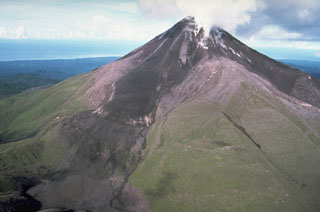Report on Bagana (Papua New Guinea) — 22 August-28 August 2007
Smithsonian Institution / US Geological Survey
Weekly Volcanic Activity Report, 22 August-28 August 2007
Managing Editor: Sally Sennert.
Please cite this report as:
Global Volcanism Program, 2007. Report on Bagana (Papua New Guinea) (Sennert, S, ed.). Weekly Volcanic Activity Report, 22 August-28 August 2007. Smithsonian Institution and US Geological Survey.
Bagana
Papua New Guinea
6.137°S, 155.196°E; summit elev. 1855 m
All times are local (unless otherwise noted)
RVO reported that an effusive lava flow from Bagana's summit crater began travelling down the SE flank on 6 August and continued flowing through 23 August. Continuous incandescence was visible down the SE flank during 6-10 August. During 6-23 August, white vapor plumes were occasionally accompanied by ash plumes that were generated by rockfalls from lava-flow edges. Based on satellite imagery, the Darwin VAAC reported that a diffuse plume rose to an altitude of 3.7 km (12,000 ft) a.s.l. on 23 August.
Geological Summary. Bagana volcano, in a remote portion of central Bougainville Island, is frequently active. This massive symmetrical cone was largely constructed by an accumulation of viscous andesitic lava flows. The entire edifice could have been constructed in about 300 years at its present rate of lava production. Eruptive activity is characterized by non-explosive effusion of viscous lava that maintains a small lava dome in the summit crater, although occasional explosive activity produces pyroclastic flows. Lava flows with tongue-shaped lobes up to 50 m thick and prominent levees descend the flanks on all sides.
Sources: Darwin Volcanic Ash Advisory Centre (VAAC), Rabaul Volcano Observatory (RVO)

